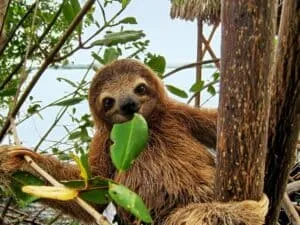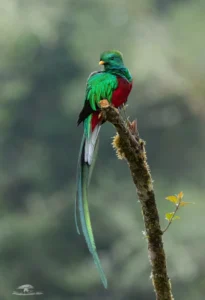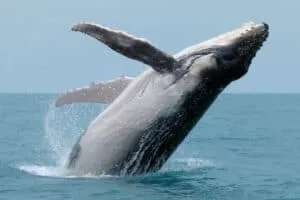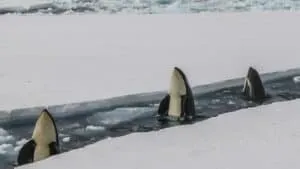
Home to more than 500,000 plant and animal species,
few countries in Latin America can compete with the volume and variety of wildlife found in Costa Rica. This wilderness paradise features a range of habitats, including mangroves, coastlines, cloud forests, and coral reefs. A staggering 25% of the country’s landmass is under active conservation.
Here are some of our animals in Costa Rica:

Hummingbirds
Costa Rica has around 50 species of hummingbirds, four of which are endemic to the region. Look out for the fiery-throated hummingbird, one of our favourites. Males are generally more brightly coloured than their female counterparts.

Blue Jeans Poison Dart Frog
Found in the forest that surrounds Puerto Viejo, strawberry poison dart frogs hunt for ants and mites. So toxic is their venom that ancient indigenous hunters used to smear their arrows with the frogs’ toxins to kill prey.

Coatimundi
Similar in appearance to a lemur, coatimundis are officially part of the raccoon family. They hang out in trees, have brown fur, and a long snout that helps them forage for insects and fruit.

White-faced Capuchin Monkeys
Found primarily in Cloud Forests, Rainforests, and Tropical Dry Forests, the White-Faced Capuchin Monkey is most commonly found in Costa Rica in Monteverde, Corcovado National Park, San Vito, Santa Rosa National Park, and Manuel Antonio National Park. Their principal natural predators include large cats, birds, snakes, and crocodiles.

Toucan
There are six species of toucan found in Costa Rica. The fiery-billed, the collared, the black mandible, and the rainbow-billed are found widely throughout the country in a range of habitats. In the cloud forest, you will see the Emerald and the Yellow-eared toucan.

Scarlet Macaws
Native to Costa Rica, the Scarlet Macaw was once almost extinct in Costa Rica, but conservation efforts have paid off and the species has made a good recovery. Their brightly coloured feathers make them easy to identity. They can be found along the Central Pacific Coast in Costa Rica, notably in Manuel Antonio National Park, Carara National Park, and Pal Verde National Park.

Sloths
A sloth is amongst the world’s slowest mammals – so sedentary, in fact, that algae grow on its furry coat. Adapted for life in the treetops, the algae gives the sloth a greenish tint that is useful camouflage. Sloths are found throughout Costa Rica, but Manuel Antonio National Park and Tortuguero National Park are the best places to see them. Sleeping up to 15-20 hours sleep every day, they eat mainly at night, feasting on leaves, shoots, and fruit from the trees.

Resplendent Quetzals
Considered by many to be the world’s most beautiful birds, these vibrantly coloured animals live in the mountainous, tropical forests of Costa Rica, where they eat fruit, insects, lizards, and other small creatures.
During mating season, male quetzals grow twin tail feathers that form a train up to three feet long. Historically, quetzals were the ancient inspiration for the Aztecs and Maya, who believed their feathers to represent the green growth of spring.

Blue Morpho Butterfly
Costa Rica is home to 90% of all butterfly populations in Central America. There are a lot of species of neotropical butterflies, as well as 18% of all butterfly species in the world. The most common are the Blue Morpho, Owl Butterfly, Florida White, and the Ruby-spotted Swallowtail butterfly.
Found throughout Costa Rica and on both coasts, the Blue Morpho is one of the world’s largest butterflies, with a wing span of up to 20 cm. They are typically seen on the edge of forests, fields, rivers, or near the ocean and are easily identified by their bright blue iridescent wings.

Leatherback Sea Turtles
Growing up to seven feet long and exceeding 2,000 pounds, Leatherbacks are the largest turtles on Earth. Once prevalent in almost every ocean, the leatherback population is in general decline. Playa Grande, in northwest Costa Rica, is the last nesting beach for Eastern Pacific leatherbacks, best observed from October through March.

Howler Monkeys
The loudest of all monkeys, Howler Monkeys are at their loudest at dawn or dusk, when their territorial cries can be heard up to 3 miles away. They are found throughout Costa Rica, but particularly in the areas around Arenal Volcano National Park, Barra Honda National Park, and Caño Negro. They are large, long-tailed, with beards and thick, predominantly, black hair.

Squirrel Monkeys
Squirrel Monkeys have a distinct appearance, generally a greenish-yellow colour, with a white throat, face, and ears, and a black muzzle and tail tip. They are generally found in the Pacific lowlands and southern part of Costa Rica.

Spider Monkeys
Spider monkeys are the smallest and most nimble of the four species of primates found in Costa Rica — but also the most endangered. They have long arms and tails that enable them to move gracefully between branches and trees. They are most commonly found in Corcovado National Park, Rincon de la Vieja National Park, Sirena Biological Station, Tenorio Volcano National Park and Peñas Blancas Wildlife Refuge. Their numbers are sadly in decline.

Leafcutter Ants
Leafcutter Ants live in huge colonies and occur throughout Costa Rica. They have powerful jaws that vibrate up to 1,000 times per second allowing them to slice through leaves. Remarkably, they can carry up to 20 times their body weight.

Baird’s Tapir
Known locally as the ‘danta’, tapir are the largest terrestrial mammal in the Nootropics. The best place to see tapir are Bijagua de Upala, Corcovado National Park on the Osa Peninsula, and Heredia.

Humpback Whales
Costa Rica has one of the longest whale-watching seasons in the world. Humpback whales roam its Pacific coast for about 8 months of the year. It is at its peak between August and the end of October. The hot spot is along the Southern Pacific Coast from Manuel Antonio to the warm waters of the Osa Peninsula, with Osa’s Golfo Dulce often used as a nursery for their young.
Related Stories

Cathy Brown’s Advice on Mendoza, Argentina | Plan South America

Adventure To The White Continent | Plan South America

Horses and Huskies in Wild Patagonia | Plan South America

Off-Grid Honeymoon | The Ultimate Patagonian Outpost
@plansouthamerica

